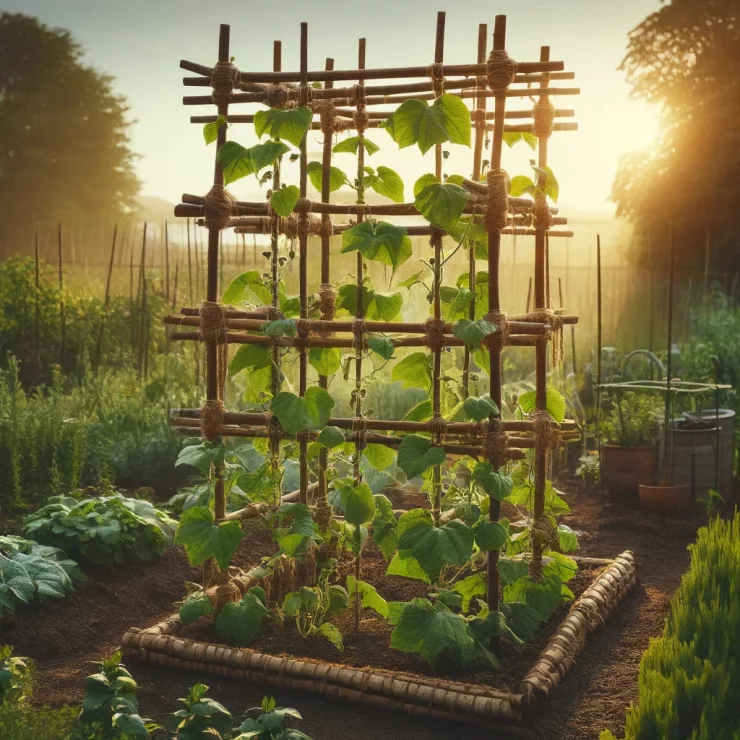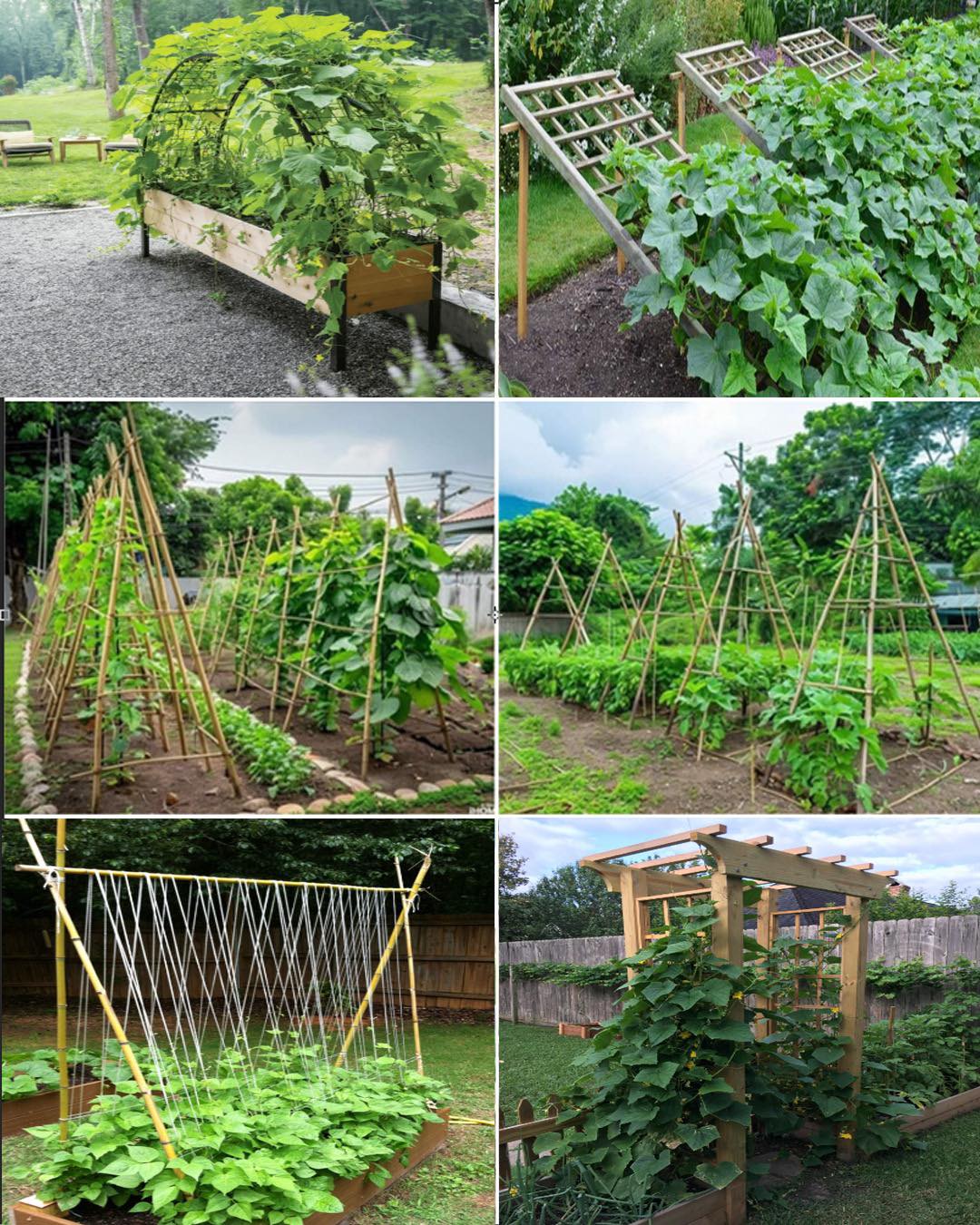Are you ready to elevate your cucumber game in the garden? Say goodbye to unruly vines and crowded patches, and hello to a simple and cost-effective solution: the DIY cucumber trellis. With just a few materials and minimal effort, you can create a sturdy support system that promotes healthier plants and more abundant yields. Follow these easy steps to build your own cucumber trellis without breaking the bank.

Materials Needed:
Wooden stakes or bamboo poles (6-8 feet in length)
Twine or garden wire
Hammer or mallet
Scissors or garden shears
Step 1: Choose Your Location
Select a sunny spot in your garden with well-drained soil. Cucumbers thrive in full sunlight, so pick a spot that receives at least 6-8 hours of direct sunlight per day. Ensure there is enough space for your trellis and allow for adequate airflow around the plants.
Step 2: Prepare the Ground
Clear the area of any weeds or debris and loosen the soil with a garden fork or shovel. If necessary, amend the soil with compost or organic matter to improve drainage and fertility.
Step 3: Install the Support Structure
Drive wooden stakes or bamboo poles into the ground at regular intervals along the row where you plan to plant your cucumbers. Space the stakes or poles about 2-3 feet apart to provide ample support for the growing vines. Hammer them into the ground to a depth of at least 12 inches to ensure stability.
Step 4: Create the Trellis Framework
Using twine or garden wire, tie one end securely to the top of one stake or pole. Stretch the twine horizontally to the next stake or pole and wrap it around several times, making sure it is taut. Continue this process until you have created a grid-like framework between all the stakes or poles, leaving enough space between rows for easy access and harvesting.
Step 5: Plant Your Cucumbers
Plant cucumber seeds or seedlings at the base of each stake or pole, spacing them according to the recommended guidelines for the variety you are growing. Water the plants thoroughly after planting to help them establish roots.
Step 6: Train the Vines
As the cucumber plants grow, gently guide the vines onto the trellis framework, weaving them through the twine or wire. This will help support the weight of the fruit and prevent them from sprawling on the ground. Check the vines regularly and adjust as needed to encourage upward growth.

Step 7: Maintain and Harvest
Keep the cucumber plants well-watered and mulched to conserve moisture and suppress weeds. Fertilize periodically with a balanced fertilizer to promote healthy growth and fruit production. Monitor the plants for pests and diseases, and take appropriate action if necessary.
As the cucumbers begin to develop, regularly harvest them to encourage continuous production and prevent over-ripening. Use scissors or garden shears to cut the cucumbers from the vine, taking care not to damage the plant.
By following these simple steps, you can build a cucumber trellis that is both affordable and effective. Not only will it save space in your garden, but it will also improve air circulation around the plants and make harvesting a breeze. So why wait? Get started today and enjoy a bountiful harvest of fresh, homegrown cucumbers all season long!
News
JJ Redick reacts to Luka Doncic trade for Anthony Davis
In one of the most jaw-dropping moves of the season, the NBA landscape was rocked by the blockbuster trade involving Luka Dončić and Anthony Davis—a swap that has sent ripples of excitement, disbelief, and heated discussion through the league. Among…
Anthony Davis FULL reaction to trade to Mavericks for Luka Doncic
In a blockbuster move that sent shockwaves through the NBA and left fans reeling, Anthony Davis has been traded to the Dallas Mavericks in exchange for Luka Dončić. In the immediate aftermath of the news, Davis took to the media…
Shaq reacts to Dallas Mavericks wanting Kevin Durant after Luka-AD trade 👀
In the constantly shifting world of the NBA, trade rumors and blockbuster moves are a regular part of the season’s drama. The latest twist has fans buzzing: the Dallas Mavericks have reportedly set their sights on acquiring Kevin Durant in…
Donovan Mitchell FILTHY poster dunk on Kristaps Porzingis 😳
In a game filled with high-intensity moments and jaw-dropping highlights, one play in particular has left fans and analysts buzzing about Donovan Mitchell’s latest display of athleticism. Early in the contest, with the atmosphere already charged by an evenly matched…
Joel Embiid hits go-ahead bucket vs Mavs then chats with Anthony Davis after game
In one of the most thrilling contests of the season, Joel Embiid delivered a clutch performance against the Dallas Mavericks, punctuating the game with a go-ahead bucket that sent the home crowd into a frenzy. The atmosphere in the arena…
D’Angelo Russell game winner as Nets hit two 3’s in 3 seconds to win vs Rockets 😱
In one of the most electrifying moments in recent NBA history, D’Angelo Russell delivered an unforgettable game-winner that left fans and commentators in complete awe. With the Brooklyn Nets locked in a tense battle against the Houston Rockets, the outcome…
End of content
No more pages to load











